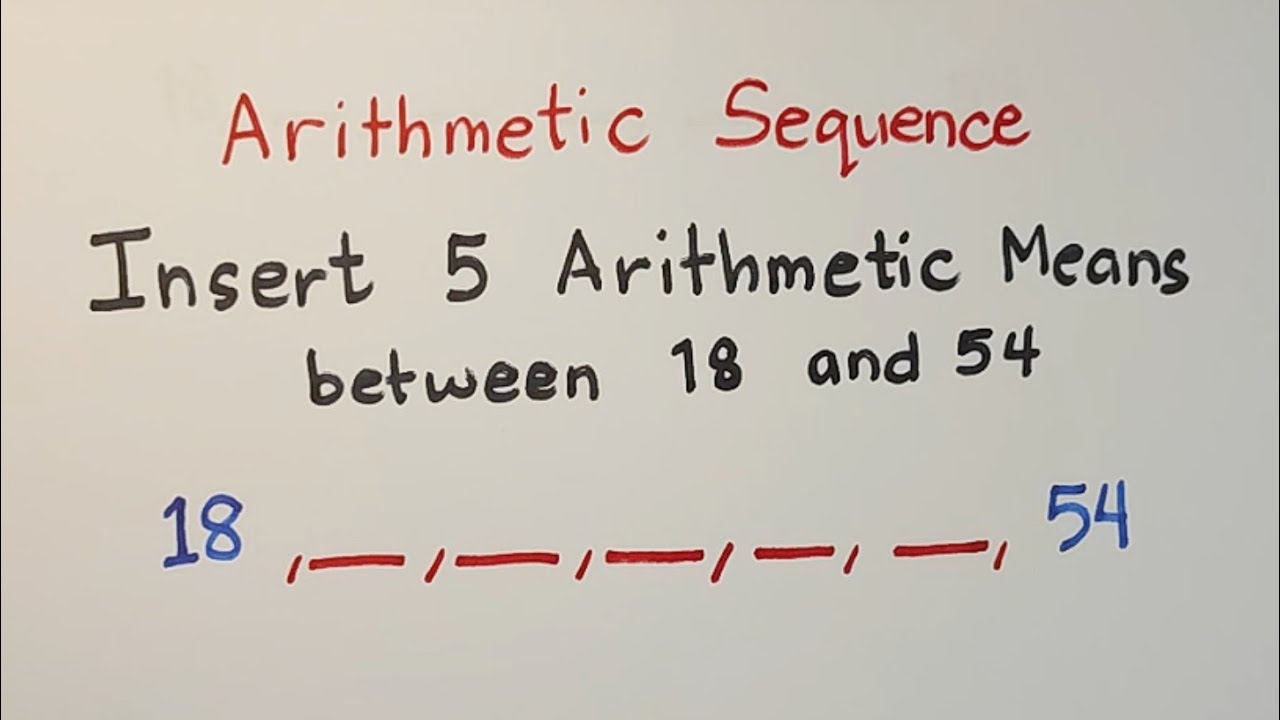ARITHMETIC SEQUENCE AND NTH TERM OF ARITHMETIC SEQUENCE || GRADE 10 MATHEMATICS Q1
Summary
TLDRThis educational video introduces the concept of an arithmetic sequence, defines its key components, and demonstrates how to find the common difference and the nth term. It provides step-by-step examples to calculate terms within a sequence and applies the concept to a real-life scenario, such as calculating salary increments over time. The video concludes with an encouragement to subscribe for more learning materials.
Takeaways
- 📚 Definition of Arithmetic Sequence: An arithmetic sequence is a sequence where a constant is added to the previous term to get the next term. This constant is called the common difference.
- 📏 Formula for nth Term: The nth term of an arithmetic sequence can be calculated using the formula: a_n = a_1 + (n - 1) * d, where a_1 is the first term and d is the common difference.
- 🔢 Finding Common Difference: The common difference (d) can be found by subtracting the first term from the second term, the second term from the third term, and so on.
- 🧮 Example Sequence 1: For the sequence 2, 5, 8, 11, the first term is 2, and the common difference is 3. The next term is 14.
- 📊 Example Sequence 2: For the sequence 1, 1 1/3, 1 2/3, 2, 2 1/3, the first term is 1, and the common difference is 1/3.
- 🔍 Example Sequence 3: For the sequence 17, 12, 7, 2, -3, the first term is 17, and the common difference is -5.
- 🔢 Finding nth Term Examples: To find the 16th term of the sequence 1, 5, 9, 13, the first term is 1, the common difference is 4, and the 16th term is 61.
- 📉 Example with Negative Difference: For the sequence 25, 23, 21, 19, 17, the first term is 25, the common difference is -2, and the 20th term is -13.
- 📐 nth Term General Formula: The nth term of the sequence 3, 7, 11, 15 is found by using the formula: a_n = 4n - 1.
- 🏢 Real-Life Application: Jeffrey’s starting yearly salary is 240,000 with raises of 20,000 per year. In the 10th year, his salary will be 420,000.
Q & A
What is an arithmetic sequence?
-An arithmetic sequence is a sequence of numbers in which each term after the first is obtained by adding a constant difference to the previous term. This constant difference is known as the common difference.
What is the common difference in an arithmetic sequence?
-The common difference in an arithmetic sequence is the constant value that is added to each term to get the next term in the sequence.
How do you find the common difference in a given arithmetic sequence?
-To find the common difference, subtract the first term from the second term (or any consecutive terms) in the sequence.
What is the formula for the nth term of an arithmetic sequence?
-The formula for the nth term of an arithmetic sequence is a_n = a_1 + (n - 1)d, where a_n is the nth term, a_1 is the first term, and d is the common difference.
How can you find the first term of an arithmetic sequence if you know the common difference and a later term?
-If you know the common difference and a later term, you can find the first term by rearranging the nth term formula to a_1 = a_n - (n - 1)d and solving for a_1.
What is the 16th term of the arithmetic sequence 1, 5, 9, 13?
-The 16th term of the sequence can be found using the nth term formula. Here, the first term a_1 is 1, and the common difference d is 4. So, the 16th term a_{16} is 1 + (16 - 1) * 4 = 61.
What is the 20th term of the arithmetic sequence 25, 23, 21, 19?
-The 20th term of this sequence can be calculated using the nth term formula. The first term a_1 is 25, and the common difference d is -2. Thus, the 20th term a_{20} is 25 + (20 - 1) * (-2) = -13.
How do you find the nth term formula for an arithmetic sequence?
-The nth term formula for an arithmetic sequence is derived from the understanding that each term is the first term plus the sum of the common difference added n - 1 times.
What is the real-life application of arithmetic sequences mentioned in the script?
-The script mentions a real-life application where a company offers an employee a starting yearly salary with annual raises. The salary in any given year can be calculated using the arithmetic sequence formula, where the first term is the starting salary, and the common difference is the annual raise.
What will be Jeffrey's salary in the 10th year if he starts with a salary of 240,000 and receives a raise of 20,000 per year?
-Using the arithmetic sequence formula, Jeffrey's salary in the 10th year will be 240,000 + (10 - 1) * 20,000 = 420,000.
Outlines

This section is available to paid users only. Please upgrade to access this part.
Upgrade NowMindmap

This section is available to paid users only. Please upgrade to access this part.
Upgrade NowKeywords

This section is available to paid users only. Please upgrade to access this part.
Upgrade NowHighlights

This section is available to paid users only. Please upgrade to access this part.
Upgrade NowTranscripts

This section is available to paid users only. Please upgrade to access this part.
Upgrade NowBrowse More Related Video

Harmonic Sequence (Tagalog/Filipino Math)

Finding the Arithmetic Means - Arithmetic Sequence Grade 10 Math

GCSE Maths - How to Write Expressions for the nth term of Arithmetic Sequences #55

Matematika SMA - Barisan dan Deret (1) - Barisan Aritmatika, Rumus Barisan Aritmatika (A)

GEOMETRIC SEQUENCE || GRADE 10 MATHEMATICS Q1

Arithmetic Sequence vs Geometric Sequence
5.0 / 5 (0 votes)